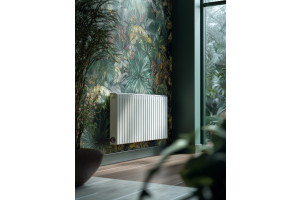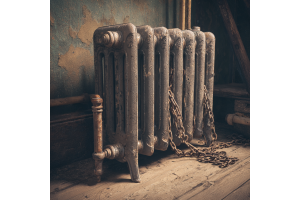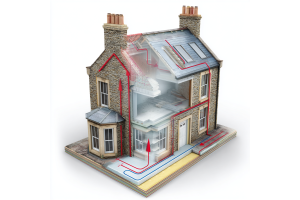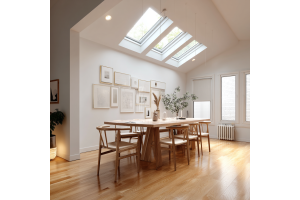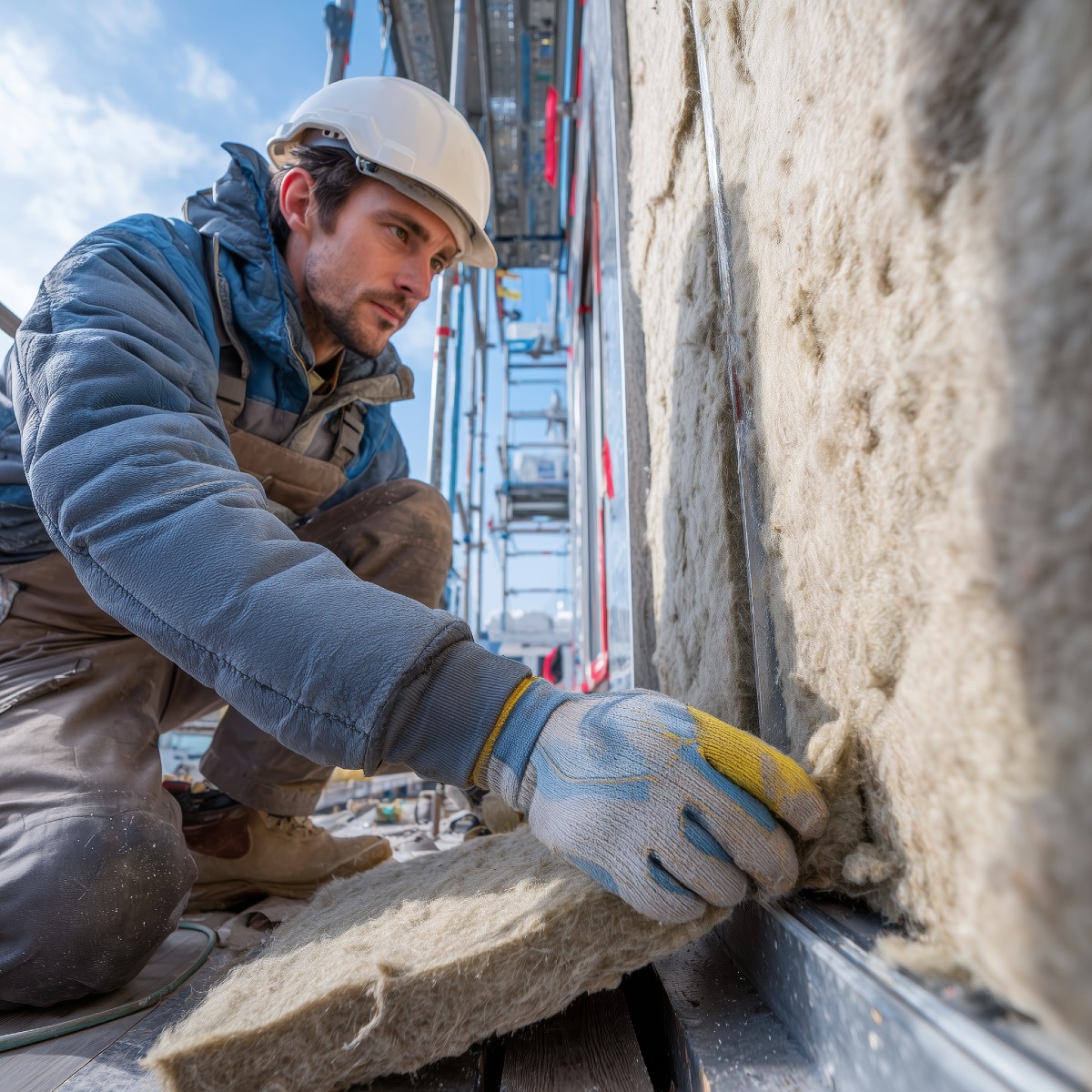
Keeping your home warm and comfortable during the colder months can often feel like a battle between rising energy costs and the limitations of your heating system. But here’s the good news: before you even think about upgrading your boiler or investing in new radiators, the most cost-effective step you can take is often to reduce the amount of heat your home loses in the first place. That’s where insulation and draught-proofing come in.
It’s easy to underestimate just how much energy slips through the cracks of an average house. Research from the Energy Saving Trust shows that:
-
Around 25% of heat escapes through an uninsulated roof,
-
Up to 33% is lost through walls, and
-
10–20% vanishes through floors and gaps.
These figures highlight that even the most efficient heating system will underperform if your home isn’t well sealed. Essentially, insulation acts like a warm blanket wrapped around your property, while draught-proofing closes the sneaky gaps that allow cold air in and warm air out.
The benefits go beyond energy savings. A well-insulated and draught-proofed home is:
-
More comfortable, with fewer cold spots and chilly draughts.
-
Cheaper to run, with potential annual savings of hundreds of pounds.
-
Kinder to the environment, reducing household carbon emissions.
-
Supportive of heating efficiency, meaning your Geyser radiators can maintain warmth at lower thermostat settings.
The best part? Many insulation and draught-proofing measures are simple and affordable DIY projects — such as fitting door seals, insulating a hot water tank, or using chimney balloons. Others, like loft or cavity wall insulation, may require professional installation but often pay for themselves within a few years.
In this guide, we’ll explore the most effective insulation strategies and practical draught-proofing techniques that can make a real difference. Whether you’re looking for quick fixes or planning bigger home improvements, these tips will help you create a warmer, more energy-efficient, and future-ready home.
Why It Matters
When most homeowners think about heating, they focus on their boiler, thermostat, or radiators. But in truth, the biggest difference in warmth and energy efficiency often comes not from how much heat you generate — but from how much of it you actually keep.
Studies from the Energy Saving Trust highlight just how significant the problem is:
-
A quarter (25%) of household heat is lost through an uninsulated roof.
-
Up to 33% escapes through walls — especially in older properties with solid wall construction.
-
10–20% seeps away through floors, cracks, gaps, and draughts.
This means that in a typical home, more than half of your heating effort may be wasted, forcing your boiler and radiators to work harder than necessary.
The Real-World Impact
-
Rising Energy Bills: With gas and electricity prices still volatile, every bit of wasted heat translates into wasted money. Draught-proofing alone can save the average household between £60–£100 a year, while loft and wall insulation can cut bills by several hundred pounds.
-
Comfort & Consistency: Insulation prevents those frustrating cold spots, chilly corners, and sudden draughts that make some rooms feel unwelcoming, even when the heating is on.
-
Health Benefits: A well-insulated, draught-free home stays warmer and drier, reducing the risk of damp, condensation, and associated health problems such as mould and respiratory issues.
-
Lower Carbon Emissions: Home heating accounts for around 14% of the UK’s total greenhouse gas emissions. By keeping heat inside, you directly cut your household’s carbon footprint.
-
Heating System Efficiency: Radiators — including Geyser’s aluminium and designer ranges — perform best when the building envelope holds in warmth. Well-sealed rooms allow radiators to run at lower temperatures while still keeping you comfortable.
Future-Proofing Your Home
With government initiatives like the Future Homes Standard and long-term goals to phase out gas boilers, insulation and draught-proofing are becoming even more important. They’re not just short-term cost savers — they’re essential upgrades that will prepare your home for the shift toward low-carbon heating technologies like heat pumps and hydrogen-ready boilers.
Put simply: without proper insulation and draught-proofing, you’re paying for heat you’ll never feel. By tackling the problem now, you’ll enjoy immediate comfort and savings while making your home future-ready for greener heating solutions.
Top Insulation Measures: Where to Focus First
Not all insulation is equal — some upgrades give faster returns and greater comfort than others. If you’re unsure where to begin, these are the priority areas most homes should tackle first.
1. Loft & Roof Insulation – The First Line of Defence
Heat rises, which is why your roof is one of the biggest culprits for energy loss. Without insulation, around a quarter of your home’s heat escapes through the roof.
-
What it involves: Laying mineral wool rolls, rigid foam boards, or blown cellulose between and over joists in your loft.
-
Cost: Typically £300–£400 for DIY, or £500–£1,000 for professional installation (depending on loft size).
-
Savings: Up to £285 per year on energy bills in a detached house.
-
Payback time: Around 2–3 years, making it one of the fastest-return upgrades.
-
Bonus tip: Don’t forget to insulate your loft hatch and seal around it — it’s a common draught point.
With a well-insulated roof, Geyser radiators won’t have to fight against constant upward heat loss, keeping rooms warmer for longer.
2. Wall Insulation – Tackling the Biggest Heat Loss
Walls account for the largest share of heat loss in a property (up to 33%). The type of wall you have determines the solution.
-
Cavity walls (common in post-1920s homes): Insulation can be blown into the gap between inner and outer walls.
-
Cost: Around £800–£1,500 for an average semi-detached home.
-
Savings: Up to £300 per year.
-
-
Solid walls (common in pre-1920s homes): Require internal (insulating boards) or external cladding.
-
Cost: £8,000–£15,000 depending on size and finish.
-
Savings: Up to £450 per year.
-
While solid wall insulation is a bigger investment, government schemes like the Great British Insulation Scheme can significantly reduce upfront costs.
3. Floor Insulation – Comfort Underfoot
Cold floors don’t just feel uncomfortable — they account for 10–20% of home heat loss.
-
Suspended timber floors: Insulate by fitting mineral wool or rigid boards between joists from below (if accessible).
-
Concrete floors: Use insulating boards before laying new flooring.
-
Cost: £1,000–£2,500 for an average home.
-
Savings: £60–£110 per year.
Even small measures, like using thick rugs or draught excluders at skirting boards, can make a noticeable difference.
4. Windows & Glazing – Stopping the Chill
Single-glazed windows are one of the fastest ways to lose heat.
-
Double glazing: Can cut heat loss by 50% compared to single glazing.
-
Triple glazing: Offers even greater performance but comes at a higher cost.
-
Secondary glazing: A budget-friendly option, especially for period homes.
-
Cost: £4,000–£7,000 for a full house replacement.
-
Savings: Around £150–£200 per year.
Add thermal curtains or blinds for extra insulation and instant comfort.
5. Hot Water Cylinder & Pipe Insulation – A Quick Win
If your home still has a hot water cylinder, wrapping it up is one of the cheapest and most effective fixes.
-
Cylinder jackets: Cost £20–£30, but save £40+ annually.
-
Pipe lagging: Just a few pounds per metre, reducing heat loss and protecting pipes from freezing.
-
Payback time: A matter of months.
6. Draught-Proofing – Small Fixes, Big Impact
While not “insulation” in the traditional sense, draught-proofing is equally important. Sealing gaps around windows, doors, floors, and chimneys can save £60–£125 per year — and instantly improve comfort.
Where to Start: The Priority Order
If you’re unsure how to phase improvements, follow this priority:
-
Loft insulation – cheapest and highest impact.
-
Cavity wall insulation – excellent value in newer homes.
-
Floor insulation & draught-proofing – comfort and savings combined.
-
Windows & glazing – more costly but boosts comfort and aesthetics.
-
Cylinder & pipe insulation – quick DIY savings.
-
Solid wall insulation – long-term, higher-cost solution.
The bottom line: Focus on roofs and walls first, then tackle floors and gaps, and finally consider glazing upgrades. Each step makes your home warmer, more efficient, and ensures your radiators deliver maximum comfort without wasted heat.
Draught-Proofing Essentials: Where to Seal for Maximum Impact
Even the best-insulated walls and roof won’t stop warm air from escaping if your home is riddled with gaps. Draughts are small, but together they can account for 10–20% of household heat loss — the equivalent of leaving a small window open all winter. The good news is that draught-proofing is one of the simplest, cheapest, and quickest energy-saving measures you can take.
Here’s where to look, and what to do:
1. Doors & Frames
-
Problem: Gaps around external doors let cold air in and warm air out.
-
Solution:
-
Fit draught-excluder brush or rubber strips around the frame.
-
Install a brush or flap seal at the bottom of the door.
-
Use portable draught snakes (fabric tubes) as a quick, low-cost fix.
-
-
Savings: Around £25–£35 per year depending on door size and location.
2. Windows
-
Problem: Old single-glazed or ill-fitting windows leak heat.
-
Solution:
-
Use self-adhesive foam strips (cheap and DIY-friendly).
-
For larger gaps, choose silicone sealant or rubber seals.
-
Add secondary glazing film kits in winter for extra protection.
-
-
Bonus Tip: Close curtains or blinds at dusk — heavy or thermal curtains can reduce heat loss through windows by 25–30%.
3. Letterboxes & Keyholes
-
Problem: Small openings that constantly leak cold air.
-
Solution:
-
Fit a letterbox brush or cover.
-
Add a simple keyhole cover for external doors.
-
-
Cost: Typically under £15, with instant results.
4. Floors & Skirting Boards
-
Problem: Gaps between floorboards or along skirting edges allow draughts to rise from below.
-
Solution:
-
Fill small gaps with flexible floor sealant or wood filler.
-
Use expanding foam for larger openings.
-
Lay thick rugs for both insulation and comfort.
-
-
Savings: Up to £40–£60 a year in older homes with timber floors.
5. Chimneys & Fireplaces
-
Problem: Unused chimneys act like funnels, pulling warm air straight out of your home.
-
Solution:
-
Fit a removable chimney balloon or draught excluder.
-
Seal off disused fireplaces with a vented cover (to maintain airflow).
-
-
Savings: Around £60 annually according to Energy Saving Trust.
6. Loft Hatches
-
Problem: Warm air escapes easily into uninsulated lofts through unsealed hatches.
-
Solution:
-
Add foam strips around the hatch edges.
-
Insulate the hatch door with rigid board or foil-backed insulation.
-
7. Pipes, Cabling & Service Gaps
-
Problem: Small gaps around pipework, extractor fans, and electrical wiring let draughts in.
-
Solution:
-
Seal with silicone sealant or expanding foam.
-
Check behind sinks, under stairs, and around boilers.
-
8. Cracks in Walls or Ceilings
-
Problem: Shrinkage cracks in plaster or masonry may create cold draught paths.
-
Solution:
-
Use breathable fillers indoors.
-
For external cracks, use cement or exterior-grade filler to block gaps.
-
DIY or Professional?
-
DIY-friendly tasks: Sealing windows, doors, keyholes, floors, and loft hatches.
-
Professional help: Period properties or listed homes, where incorrect sealing could cause damp or ventilation issues.
The Benefits of Draught-Proofing
-
Lower bills: Potential savings of £60–£125 a year in an average UK home.
-
Improved comfort: No more cold corners or sudden chills near windows and doors.
-
Heating efficiency: Radiators can heat your home more evenly and effectively when warm air stays inside.
-
Quick payback: Most draught-proofing products cost under £50 and last for years.
The Bottom Line: Draught-proofing is one of the fastest, cheapest ways to improve comfort and reduce energy use. Think of it as “tightening the seal” on your heating system — ensuring every bit of warmth your Geyser radiators produce stays where it belongs.
Finding & Tackling Hidden Draughts
Even after sealing doors, windows, and chimneys, many homes still leak heat through less obvious gaps. These “hidden draughts” are often small, but together they can cause significant energy waste and comfort loss. Learning how to find and fix them will help you maximise your heating system’s efficiency.
1. How to Detect Hidden Draughts
-
The Hand Test: On a cold day, run your hand slowly around skirting boards, floor edges, window frames, and electrical fittings to feel for cool air movement.
-
Candle/Incense Test: Hold a lit candle or incense stick near suspected gaps (taking safety precautions). If the flame flickers or smoke drifts, air is moving.
-
Thermal Imaging: For a high-tech option, thermal cameras (or even some smartphone add-ons) can reveal exactly where heat is escaping.
-
Professional Blower Door Test: Energy assessors can pressurise your home to measure air leakage and locate problem areas.
2. Common Hidden Draught Sources & Fixes
a) Loft Hatch & Attic Gaps
-
Problem: Warm air rises and escapes through unsealed loft hatches, downlight holes, or gaps around attic flooring.
-
Solution:
-
Fit draught-proofing strips around the hatch.
-
Insulate the hatch door with rigid foam board or foil-backed insulation.
-
Seal gaps around loft boarding with expanding foam.
-
b) Floorboards & Joist Gaps
-
Problem: Victorian and Edwardian houses often have draughty suspended timber floors. Cold air rises from the void below.
-
Solution:
-
Use flexible filler or draught-proofing strips between floorboards.
-
Lay rugs or carpets in high-use rooms.
-
Consider underfloor insulation for a long-term fix.
-
c) Electrical Outlets & Light Fittings
-
Problem: Plug sockets, switches, and ceiling lights on external walls often leak small but steady draughts.
-
Solution:
-
Install foam gasket pads behind switch plates and sockets.
-
Use draught-proof covers for unused outlets.
-
Seal gaps around recessed lights with fire-safe caulking (never block ventilation around hot bulbs).
-
d) Pipe & Cable Entry Points
-
Problem: Holes drilled for pipes, wires, and vents often bypass walls, floors, and ceilings.
-
Solution:
-
Seal gaps with silicone sealant (for small holes) or expanding foam (for larger ones).
-
Use pipe collars or grommets for a neat, durable finish.
-
e) Built-in Cupboards & Wardrobes
-
Problem: Older homes sometimes have cupboards built against cold external walls, allowing draughts in through cracks.
-
Solution:
-
Line cupboards with thin insulation board.
-
Seal cracks at skirting and corners with filler.
-
Keep cupboard doors closed in winter to stop air circulation.
-
f) Around Radiator Pipes
-
Problem: Gaps where radiator pipes pass through floors or walls often let cold air in from voids below.
-
Solution:
-
Use pipe collars or caulk sealant to close gaps.
-
This improves radiator efficiency and reduces cold spots.
-
3. The Balance: Draught-Proofing vs Ventilation
While tackling hidden draughts is key to comfort and savings, it’s equally important not to over-seal your home. Proper ventilation prevents condensation, damp, and indoor air quality issues.
-
Always leave trickle vents on windows open if they’re fitted.
-
Use kitchen and bathroom extractor fans to manage moisture.
-
Never block intentional air bricks or vents for gas appliances.
4. Benefits of Tackling Hidden Draughts
-
Energy savings: Up to £100–£150 a year in a typical home, on top of regular draught-proofing savings.
-
Comfort: No more unexplained “cold corners” or chilly floors near radiators.
-
System efficiency: Your radiators and heating system can operate more evenly, reducing the need to overheat rooms.
-
Peace of mind: Small fixes can prevent long-term issues like damp, mould, or warped floors.
Key Takeaway: Tackling hidden draughts transforms a house from “warm in some places, cold in others” to evenly comfortable. It’s about making your heating work with your home, not against it.
Ventilation: Balance Is Key
When draught-proofing and insulating your home, it’s easy to think that blocking every possible gap will lead to the best energy savings. But a house that’s too tightly sealed can trap moisture and pollutants, leading to damp walls, mould growth, stale air, and even increased risks for respiratory problems. Good ventilation is just as important as insulation for a warm, healthy, and efficient home.
1. Why Ventilation Matters
-
Moisture Control: Everyday activities like cooking, showering, and even breathing release litres of water vapour. Without escape routes, this builds up as condensation on cold surfaces, encouraging mould.
-
Air Quality: Fresh air circulation removes pollutants, allergens, and carbon dioxide, keeping your indoor environment healthier.
-
Appliance Safety: Gas boilers, fireplaces, and some heaters need a supply of oxygen. Blocking air vents can be dangerous, risking carbon monoxide build-up.
2. Good Draughts vs. Bad Draughts
Not all air movement is bad.
-
Bad Draughts: Uncontrolled, unwanted cold air sneaking in through gaps in floors, windows, and walls. These cause discomfort and wasted heating.
-
Good Draughts (Ventilation): Controlled airflow from deliberate sources like trickle vents, extractor fans, or mechanical ventilation systems. These keep the home healthy while still protecting warmth.
3. Best Practices for Healthy Ventilation
-
Keep Trickle Vents Open: Many modern windows come with small vents at the top. These allow continuous, gentle airflow without major heat loss.
-
Use Extractor Fans:
-
In kitchens (above hobs) to remove steam, grease, and smells.
-
In bathrooms to prevent condensation from showers and baths.
-
Choose fans with humidity sensors or timers so they only run when needed.
-
-
Allow Background Ventilation: A small amount of steady airflow is more efficient than letting moisture build up and then tackling the problem later.
-
Vent Chimneys & Fireplaces: Even if not in use, leave a vented cover to maintain airflow and prevent damp.
-
Maintain Air Bricks: Older homes often rely on these for underfloor ventilation — don’t block them when draught-proofing.
4. Advanced Solutions for Modern Homes
If your home is well-insulated or newly built, you may need more sophisticated ventilation options:
-
MVHR (Mechanical Ventilation with Heat Recovery): Extracts stale air while recovering heat to warm incoming fresh air. Efficient for airtight homes.
-
Positive Input Ventilation (PIV): Pushes filtered air into your home from a loft or wall unit, improving circulation and reducing condensation.
-
Smart Ventilation Controls: Some systems adjust airflow automatically depending on humidity and occupancy levels.
5. Signs of Poor Ventilation
-
Condensation on windows in the morning.
-
Musty smells, especially in bedrooms or cupboards.
-
Black mould in corners or behind furniture.
-
Air feeling stale or stuffy, even when heating is on.
6. Finding the Right Balance
The goal is to block wasteful draughts while still allowing controlled ventilation where it’s needed most. A well-balanced home feels warm, dry, and fresh, with lower energy bills and fewer health risks.
Key Takeaway: Think of draught-proofing and ventilation as two halves of the same coin. Insulation and sealing keep heat in, while smart ventilation ensures your home stays breathable, safe, and healthy. Together, they create a home that’s both energy-efficient and comfortable.
DIY vs Professional: Which Approach Is Right for You?
Insulating and draught-proofing your home can range from quick DIY weekend jobs to large-scale projects that require specialist skills. The right choice depends on your budget, the age and type of your property, and how confident you are with tools and materials. Getting this balance right ensures you save money in the short term without compromising long-term performance or safety.
1. What You Can Do Yourself
Many draught-proofing and light insulation tasks are affordable, quick, and DIY-friendly.
-
Doors & Windows:
-
Apply self-adhesive foam or rubber seals around frames.
-
Fit brush strips at the bottom of doors.
-
Add DIY secondary glazing film kits to single-glazed windows.
-
-
Floors & Skirting Boards:
-
Seal gaps with flexible filler or caulk.
-
Use rugs or carpets to block cold from below.
-
-
Chimneys:
-
Insert removable chimney balloons or draught excluders.
-
-
Loft Hatch:
-
Add foam strips around the hatch and insulate the cover.
-
-
Letterboxes & Keyholes:
-
Install covers or brush fittings.
-
-
Pipes & Cable Holes:
-
Seal small gaps with silicone or expanding foam.
-
Cost & Payback: Many of these fixes cost £10–£50 each, and the savings often cover the investment within a year.
2. When to Call in a Professional
Some projects need specialist knowledge, tools, or certification to ensure safety and compliance.
-
Loft Insulation (full coverage): Correct installation is essential to avoid damp, compression of insulation, or blocking ventilation.
-
Cavity Wall Insulation: Needs proper materials and testing to avoid moisture bridging and mould issues.
-
Solid Wall Insulation (internal or external): Can significantly improve performance but requires skilled installation to prevent thermal bridging and condensation risks.
-
Underfloor Insulation: Particularly in older homes with suspended timber floors — access is tricky, and incorrect installation may cause rot or damp.
-
Advanced Ventilation Systems (MVHR or PIV): Proper design and setup is crucial for efficiency and indoor air quality.
-
Listed Buildings / Period Homes: Professional assessment ensures heritage features are preserved while still improving efficiency.
Why it matters: Poorly executed insulation can trap moisture, damage building fabric, or even make heating less efficient.
3. The Middle Ground
Some homeowners start with DIY for quick wins, then bring in professionals for major upgrades. For example:
-
DIY sealing of windows and loft hatch → Professional loft insulation installation.
-
Draught-proofing gaps in floors → Professional underfloor insulation.
-
Adding DIY radiator pipe collars → Professional heating system balancing.
This staged approach spreads the cost and ensures every job is done to the right standard.
4. Questions to Ask a Professional
If you’re hiring an installer, check:
-
Accreditation: Are they certified (e.g., TrustMark, PAS2030 for insulation, Gas Safe for heating work)?
-
Experience: Have they worked on homes similar to yours?
-
Guarantees: What warranty or insurance-backed guarantee is provided?
-
Ventilation Plan: How will they ensure your home stays well-ventilated after insulation?
-
Costs vs Savings: Can they provide an estimate of annual energy bill reductions?
5. Key Benefits of Each Approach
-
DIY:
-
Low cost, quick payback, immediate improvements.
-
Great for small draughts and easy-access areas.
-
-
Professional:
-
Larger savings long term (loft, wall, underfloor insulation).
-
Reduced risk of errors or unintended issues.
-
Often eligible for government grants or schemes.
-
Key Takeaway: Use DIY for small, inexpensive fixes that boost comfort right away, and trust professionals for major insulation upgrades. The combination of both strategies delivers the best results: lower bills, warmer rooms, and a home that allows your Geyser radiators to perform at their best.
Additional Cost-Savers & Inspirations
Once you’ve tackled insulation and draught-proofing, there are plenty of other clever ways to stretch your heating budget further. Some are quick DIY upgrades, others involve small investments that pay back quickly, and a few are lifestyle adjustments that make a big difference over the winter months.
1. Reflect More Heat Back into the Room
-
Radiator Reflectors: Install reflective panels or foil behind radiators on external walls. These bounce heat back into the room instead of letting it escape through walls.
-
Cost: From just £10–£20 for a roll.
-
Savings: Around £20–£30 per year per radiator.
2. Upgrade Curtains & Blinds
-
Thermal Curtains: Heavy, lined curtains can reduce heat loss through windows by 25–30%.
-
Layering: Use a combination of blinds + curtains for maximum insulation.
-
Smart Tip: Open curtains during the day to benefit from solar gain and close them as soon as the sun sets to trap warmth.
3. Make Use of Rugs & Soft Furnishings
-
Bare floors can leak heat — especially in homes with suspended timber floors.
-
Adding thick rugs in living rooms and bedrooms not only improves comfort but also prevents heat loss through floors.
4. Optimise Radiator Performance
-
Bleed Radiators: Remove trapped air to ensure they heat evenly.
-
Balance Your System: Adjust radiator valves so every room warms consistently.
-
Add Thermostatic Radiator Valves (TRVs): Control room-by-room heating and avoid wasting energy on unused spaces.
-
Smart Controls: Pair with a programmable thermostat to fine-tune heating schedules.
5. Use Doors to Your Advantage
-
Keep internal doors closed to trap heat in occupied rooms.
-
For draughty hallways, consider adding door curtains or draught excluders for extra warmth.
6. Small DIY Upgrades
-
Pipe Insulation: Foam lagging around hot water pipes reduces heat loss and keeps water warmer for longer.
-
Hot Water Cylinder Jacket: For older systems, an insulated jacket can save £50+ a year.
-
Gap Fillers: Even after main draught-proofing, regularly check for new gaps around skirting, windows, and pipes.
7. Smart Habits & Lifestyle Tweaks
-
Lower the Thermostat by 1°C: This can cut heating bills by up to 10% without noticeable discomfort.
-
Heat Only Occupied Rooms: Use TRVs or smart heating zones.
-
Layer Up at Home: Warm clothing and blankets reduce reliance on constant high heating.
-
Batch Cooking: Use the oven for several dishes at once, and let residual heat warm the kitchen.
8. Explore Renewable Heating Add-Ons
For those planning bigger upgrades:
-
Solar Panels: Help power electric heating or offset energy costs.
-
Air Source Heat Pumps: Can pair with high-performance radiators for efficient, low-carbon heating.
-
Hybrid Heating Systems: Combine a traditional boiler with renewable technology for the best of both worlds.
9. Government Grants & Incentives
Check if you’re eligible for schemes like:
-
ECO4 (Energy Company Obligation): For loft, wall, and floor insulation.
-
Boiler Upgrade Scheme: Provides grants for replacing old boilers with low-carbon alternatives.
-
Local Council Support: Some offer extra funding for insulation or heating upgrades.
10. Inspiration: Create a “Cosy Zone”
Sometimes the best energy-saving strategy isn’t heating the whole house but making key spaces extra comfortable.
-
Focus on living rooms and bedrooms where you spend most time.
-
Layer with soft furnishings, rugs, and curtains.
-
Ensure Geyser radiators are placed for maximum impact (not blocked by furniture or curtains).
Key Takeaway: Beyond insulation and draught-proofing, small upgrades, habits, and smart heating tweaks can add up to hundreds of pounds saved each year. Even better, they make your home feel warmer, more stylish, and more efficient — all while letting your radiators perform at their best.
Quick Takeaways: Your Efficiency Checklist
Improving your home’s insulation and tackling draughts doesn’t need to be overwhelming. Here’s a step-by-step checklist to help you stay on track, save money, and get the most from your Geyser radiators.
Insulation Priorities
-
Loft insulation: Ensure at least 270mm of insulation in your loft or attic.
-
Wall insulation: Check if your walls are cavity-filled or need solid wall solutions.
-
Floor insulation: Seal or insulate suspended timber floors to stop heat escaping from below.
-
Loft hatch: Seal and insulate the hatch to prevent rising warm air leaks.
Draught-Proofing Must-Dos
-
Doors: Fit brush strips at the bottom and rubber seals around frames.
-
Windows: Add foam/rubber seals or secondary glazing film for single glazing.
-
Letterboxes & keyholes: Install inexpensive covers to stop constant leaks.
-
Chimneys & fireplaces: Use chimney balloons or vented covers for unused flues.
-
Floors & skirting boards: Fill gaps with caulk or flexible filler.
-
Pipes & cables: Seal service entry points with silicone or foam.
-
Radiator pipes: Fit collars to block hidden draughts.
Hidden Draught Hotspots
-
Sockets & switches: Add foam gaskets or covers to reduce air leakage.
-
Cupboards & wardrobes on external walls: Seal cracks and line with insulation if needed.
-
Cracks in walls or ceilings: Repair with appropriate filler (indoor or external).
Ventilation Balance
-
Keep trickle vents open on modern windows.
-
Use kitchen & bathroom extractor fans with timers or humidity sensors.
-
Never block air bricks or vents needed for gas appliances.
-
Consider MVHR or PIV systems for airtight or newly insulated homes.
Cost-Saving Boosters
-
Install radiator reflectors on external walls.
-
Hang thermal curtains or blinds and close them at dusk.
-
Use rugs and carpets on cold floors.
-
Bleed and balance radiators regularly.
-
Fit thermostatic radiator valves (TRVs) for room-by-room control.
-
Turn thermostat down by 1°C to cut bills by up to 10%.
-
Insulate hot water pipes and add a cylinder jacket if needed.
-
Explore grants and schemes (ECO4, Boiler Upgrade Scheme, local support).
Lifestyle Habits
-
Heat the rooms you use most, not the whole house.
-
Keep internal doors closed to trap heat.
-
Make use of sunlight by day, curtains by night.
-
Dress in layers indoors to stay warm without cranking the thermostat.
The Bottom Line
By following this checklist, you’ll create a home that’s:
-
Warmer: Fewer cold spots and draughts.
-
Cheaper to run: Energy bills reduced by hundreds of pounds a year.
-
Healthier: Fresh air without damp or mould problems.
-
Future-ready: Prepared for modern heating systems and sustainable living.
Key Takeaway: Treat this checklist as your action plan. Each tick brings you closer to a home that’s efficient, comfortable, and perfectly optimised for your Geyser heating system.
Why This Matters for Geyser Customers
For homeowners who rely on Geyser radiators, insulation and draught-proofing are more than just optional upgrades — they are essential steps to get the most out of your heating system. Even the most high-performance radiator can struggle to maintain comfort if your home leaks heat or suffers from cold spots.
1. Optimising Radiator Performance
-
Even Heat Distribution: Properly insulated rooms retain warmth longer, allowing Geyser radiators to maintain an even temperature without overworking.
-
Faster Warm-Up: When draughts are sealed and walls retain heat, radiators reach your desired room temperature more quickly, making your home feel cosy faster.
-
Lower Energy Use: Radiators don’t have to run at full power constantly, reducing energy consumption and bills.
2. Protecting Your Investment
Geyser radiators are designed for efficiency and style, but their effectiveness can be compromised if your home is poorly insulated:
-
Heat escaping through walls, floors, or gaps forces the system to work harder.
-
Cold draughts can make rooms feel chilly even when radiators are on full.
-
Over time, this can slightly reduce lifespan or efficiency due to increased strain.
Sealing your home with proper insulation and draught-proofing ensures your radiators operate under ideal conditions, maximising both comfort and durability.
3. Enhancing Comfort Room by Room
-
Geyser’s aluminium and designer radiators heat up quickly and distribute warmth efficiently, but they rely on a stable thermal environment.
-
Draught-free rooms maintain steady warmth, so there are no cold spots near windows, doors, or floors.
-
Well-insulated homes allow you to enjoy lower radiator temperatures while staying comfortable, creating energy savings without compromising warmth.
4. Supporting Smart Heating
-
Many Geyser customers use programmable thermostats or smart TRVs to control heating.
-
A draught-free, insulated home ensures these systems function accurately, because sensors and thermostats won’t be fooled by cold drafts.
-
This allows you to fine-tune heating schedules, reduce unnecessary energy use, and make the most of your smart controls.
5. Sustainability & Environmental Impact
-
Geyser customers often care about energy efficiency and reducing carbon emissions.
-
Proper insulation and draught-proofing directly reduce energy consumption, lowering your home’s carbon footprint.
-
Combined with efficient Geyser radiators, you’re making a significant contribution to greener living while enjoying modern heating comfort.
6. Long-Term Cost Savings
-
The energy savings from insulation and draught-proofing compound over time, making your heating system more economical year after year.
-
Combined with Geyser radiators’ energy-efficient design, these savings can add up to hundreds of pounds annually.
-
Investing in insulation now helps ensure that your radiators don’t need to work harder than necessary, protecting both wallet and system longevity.
Key Takeaway: For Geyser customers, insulation and draught-proofing aren’t just home improvements — they’re critical enablers that allow your radiators to perform at their peak. By reducing heat loss and eliminating cold spots, you’ll enjoy faster warming, lower energy bills, increased comfort, and a greener home, all while extending the life and efficiency of your heating system.
Conclusion
Creating a warm, energy-efficient, and comfortable home is about more than just turning up the heating. Insulation and draught-proofing are foundational steps that allow your heating system — including high-performance Geyser radiators — to operate at its best. By reducing heat loss and controlling airflow, you can enjoy a home that is cozier, healthier, and far more economical to run.
Key Takeaways
-
Insulation is the first line of defence against heat loss — start with your loft, walls, and floors to see the biggest impact.
-
Draught-proofing works hand-in-hand with insulation to seal gaps around doors, windows, chimneys, and pipes, preventing unnecessary energy waste.
-
Ventilation must be balanced — a well-sealed home still needs controlled airflow to avoid damp, mould, and poor air quality.
-
DIY vs professional: Small fixes are perfect for weekends, but larger projects like wall insulation or advanced ventilation may require experts to ensure optimal performance.
-
Additional cost-saving strategies — radiator reflectors, thermal curtains, rugs, and smart heating controls — complement insulation and draught-proofing for maximum efficiency.
-
Geyser radiators perform best in a well-sealed, insulated environment. Heat is retained longer, rooms warm faster, and energy consumption is reduced, saving you money and improving comfort.
The Bigger Picture
Investing in insulation and draught-proofing isn’t just about lower energy bills — it’s about creating a home that’s future-ready, comfortable, and sustainable. With government incentives, cost-saving upgrades, and smart lifestyle tweaks, every homeowner can take steps to improve thermal efficiency.
For Geyser customers, these improvements unlock the full potential of your radiators, letting you enjoy a warm, evenly heated home while reducing strain on your heating system and your wallet.
Action Plan
-
Conduct a home audit: identify insulation gaps and draught hotspots.
-
Prioritise quick wins: loft insulation, door/window sealing, and pipe lagging.
-
Consider professional upgrades for larger projects like wall or underfloor insulation.
-
Combine improvements with smart heating practices for long-term energy savings and comfort.
Final Thought: A warm, efficient home is achievable for every homeowner. By taking insulation, draught-proofing, and ventilation seriously, you not only protect your investment in Geyser radiators but also create a space that’s cosy, economical, and ready for the future of sustainable living.




